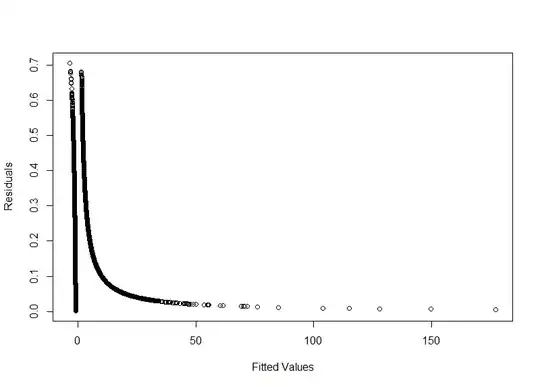I'd like to solve the heteroskedasticity in logistic regression. In my problem, I have two numeric and 23 dummies variables. I tried to transform the two numerical variables using log, min-max normalization and standard normal transformation but the model continues presenting this phenomenon. How to solve this problem?
My R output
Call:
glm(formula = TURMA_PROFICIENTE ~ ., family = "binomial", data = treinamento3,
model = T)
Deviance Residuals:
Min 1Q Median 3Q Max
-1.5633 -0.6633 -0.4702 -0.2725 3.2180
Coefficients:
Estimate Std. Error z value Pr(>|z|)
(Intercept) -11.468260 0.234033 -49.003 < 2e-16 ***
MODA_ID_DEPENDENCIA_ADM_TURMA 0.207687 0.029116 7.133 9.82e-13 ***
TAMANHO_TURMA 0.025761 0.002113 12.191 < 2e-16 ***
PERC_ALUNOS_GOSTAM_MT 0.855038 0.092606 9.233 < 2e-16 ***
TX_RESP_Q001B 0.294212 0.029333 10.030 < 2e-16 ***
TX_RESP_Q004S_EM 0.204347 0.087208 2.343 0.019119 *
TX_RESP_Q005 0.139776 0.012944 10.798 < 2e-16 ***
TX_RESP_Q008 0.073287 0.014984 4.891 1.00e-06 ***
TX_RESP_Q010 0.032345 0.006231 5.191 2.09e-07 ***
TX_RESP_Q018 0.057162 0.020725 2.758 0.005815 **
TX_RESP_Q020 0.042434 0.017486 2.427 0.015233 *
TX_RESP_Q022C 0.133927 0.031147 4.300 1.71e-05 ***
TX_RESP_Q028 0.026202 0.014779 1.773 0.076234 .
TX_RESP_Q048 0.188193 0.022012 8.549 < 2e-16 ***
TX_RESP_Q052 0.239548 0.015695 15.263 < 2e-16 ***
TX_RESP_Q054 0.031970 0.011816 2.706 0.006814 **
TX_RESP_Q060 0.036555 0.016207 2.255 0.024106 *
TX_RESP_Q074 0.166943 0.032754 5.097 3.45e-07 ***
TX_RESP_Q075 0.121384 0.033159 3.661 0.000252 ***
TX_RESP_Q095 0.206870 0.023490 8.807 < 2e-16 ***
TX_RESP_Q096 0.328982 0.016370 20.097 < 2e-16 ***
TX_RESP_Q098 0.117467 0.033336 3.524 0.000426 ***
TX_RESP_Q099 0.203174 0.013005 15.622 < 2e-16 ***
TX_RESP_Q106 0.469938 0.022099 21.265 < 2e-16 ***
TX_RESP_Q108 0.047157 0.015743 2.995 0.002740 **
---
Signif. codes: 0 ‘***’ 0.001 ‘**’ 0.01 ‘*’ 0.05 ‘.’ 0.1 ‘ ’ 1
(Dispersion parameter for binomial family taken to be 1)
Null deviance: 39156 on 42108 degrees of freedom
Residual deviance: 34932 on 42084 degrees of freedom
AIC: 34982
Number of Fisher Scoring iterations: 5
Breush-Pagan test
bptest(fit3)
studentized Breusch-Pagan test
data: fit3
BP = 3559.6, df = 24, p-value < 2.2e-16
